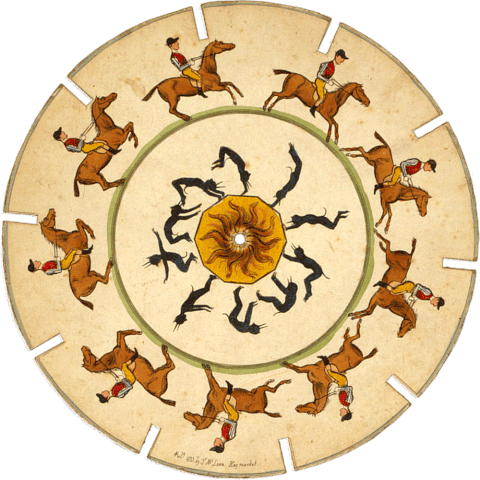
Phenakistoscopes (1833)
The Phenakistoscope — a popular Victorian parlour toy, generally marketed for children — is widely considered to be among the earliest forms of animation and the precursor to modern cinema. The device was operated by spinning the cardboard disc, and viewing the reflection of the image in a mirror through a series of moving slits. Through the distortion and flicker, the disc created the illusion that the image was moving. Women danced, men bowed, and animals leapt in short, repeating animations.
Many scientists of the era had been experimenting with optical illusions, photography, and image projections, and there was something inevitable about the creation of this device, having been simultaneously invented in 1832, by Joseph Plateau in Brussels and by Simon von Stampfer in Berlin. Plateau was a physicist, but his father had been a painter and illustrator who had enrolled his son at the Academy of Design in Brussels. Although Plateau eventually ended up pursuing science instead, he retained an interest in art and design that proved useful when creating the prototype Phenakistoscope. Plateau’s original designs were hand-painted by himself, an example of the frequent intersection of Victorian artistry with experimental scientific media that defined the period. Only weeks later, unaware of Plateau’s creation, von Stampfer, a mathematician, developed a near-identical device that he named the Stroboscope.
The device proved popular, and was soon mass-produced and marketed under some more easily-pronounceable names, including Phantasmascope, Fantoscope, and even the prosaic "Magic Wheel". The series featured here are from a competing product, Mclean’s Optical Illusions or Magic Panorama, which, published in 1833, ranks among the earliest mass-produced Phenakistoscopes. The illustrations we see here are simple moving figures but, over the following years, designs would become more and more complicated, depicting intricate, phantasmagoric scenes in high colour.
The Phenakistoscope was eventually supplanted in the popular imagination: firstly by the similar Zoetrope, and then — via Eadweard Muybridge's Zoopraxiscope (which projected the animation) — by film itself. The toy was largely forgotten, relegated to a pre-cinema curiosity. And yet strangely, in the internet age, the concept has come full circle — we find we have returned to producing and sharing similar short, looping animations, reminiscent of a device that preceded the animated GIF by over 155 years.
Aug 30, 2016






